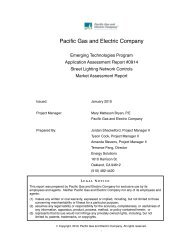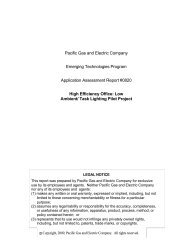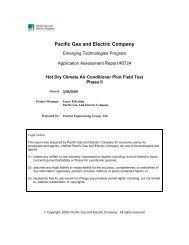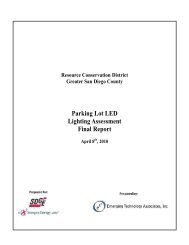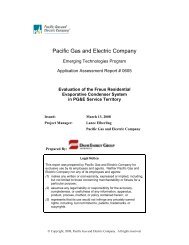Laboratory Evaluation of the OASys Indirect/Direct Evaporative
Laboratory Evaluation of the OASys Indirect/Direct Evaporative
Laboratory Evaluation of the OASys Indirect/Direct Evaporative
You also want an ePaper? Increase the reach of your titles
YUMPU automatically turns print PDFs into web optimized ePapers that Google loves.
Sensible capacity measures with ~100°Fdb/70°Fwb intake air<br />
and 0” w.g. outlet resistance<br />
Test Unit Dir In/Dir <strong>OASys</strong> SEER 12<br />
High Speed (Est.) ARI “A”<br />
Room Capacity (tons) 2 0.62 1.56 1.28 1.19 3.0<br />
Room EER (Btu/Wh) 2 10.1 19.9 26.4 24.9 10.3<br />
Outside Air Capacity (tons) 3 6.21 5.72 3.52 3.70<br />
Outside Air EER (Btu/Wh) 3 101.1 73.1 72.5 77.3<br />
Water Consumption (GPH) 4 13 14 5 5 -1<br />
Medium Speed<br />
Room Capacity (tons) 2 1.14 1.13<br />
Room EER (Btu/Wh) 2 31.6 31.4<br />
Outside Air Capacity (tons) 3 3.16 3.35<br />
Outside Air EER (Btu/Wh) 3 88.0 93.1<br />
Low Speed<br />
Room Capacity (tons) 2 0.70 1.14 1.02 0.89<br />
Room EER (Btu/Wh) 2 23.2 21.3 32.4 28.1<br />
Intake Air Capacity (tons) 3 4.25 3.69 2.84 2.82<br />
Intake Air EER (Btu/Wh) 3 141.7 68.8 90.1 88.7<br />
0.3” w.g. outlet resistance<br />
CA Title-20 ECER (Btu/Wh) High 23.2 19.0 23.1 10.3<br />
Medium 25.4<br />
Low 21.5<br />
CONCLUSIONS<br />
1 Supplied airflow referenced to <strong>the</strong> intake density.<br />
2 Room Capacity ≈ 1.08 × CFM × (80°F – Tsupply)/12,000<br />
3 Outside Air Capacity ≈ 1.08 × CFM × (Tintake – Tsupply)/12,000<br />
4 The comparison units had continuous bleed systems<br />
Dir: Advanced direct evaporative cooler with 8”-thick cellulose pad<br />
In/Dir: “Dir” with add-on indirect evaporative precooler<br />
This study investigated <strong>the</strong> performance <strong>of</strong> a commercially available example <strong>of</strong> <strong>the</strong> <strong>OASys</strong> two-stage<br />
evaporative cooler. The primary advantage <strong>of</strong> <strong>the</strong> <strong>OASys</strong> in relation to direct evaporative coolers is that<br />
it can achieve lower supply temperatures while simultaneously adding less moisture to <strong>the</strong> space. The<br />
disadvantages are that <strong>the</strong> system is more complex and more expensive than direct units are, and <strong>the</strong><br />
supply airflow is low. However, this unit still uses considerably less power than a conventional air<br />
conditioner or most o<strong>the</strong>r evaporative coolers, and will likely keep a space more comfortable than o<strong>the</strong>r<br />
evaporative coolers for more <strong>of</strong> <strong>the</strong> cooling season. As this evaluation was only a series <strong>of</strong> short-term<br />
tests, <strong>the</strong>y give no indication <strong>of</strong> its long-term reliability or maintenance requirements in actual use.<br />
Some <strong>of</strong> <strong>the</strong> key findings are summarized below.<br />
1. With three fan speeds and various combinations <strong>of</strong> exhaust damper position, supply outlet resistance,<br />
and intake dry- and wet-bulb temperatures, <strong>the</strong>re were more tests done on this unit than for any <strong>of</strong> <strong>the</strong><br />
evaporative cooler systems evaluated in previous application assessments. However, even with <strong>the</strong><br />
larger number, it was not a goal to determine which combination <strong>of</strong> settings provided <strong>the</strong> best<br />
operating performance, and <strong>the</strong> test results did not point towards one.<br />
2. The wet-bulb effectiveness varied from 98% to 112% over <strong>the</strong> range <strong>of</strong> test conditions. It was only<br />
under 100% for a very few tests when <strong>the</strong>re was no resistance on <strong>the</strong> supply outlet and <strong>the</strong> fan was on<br />
491-06.12.doc 20




